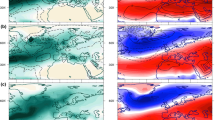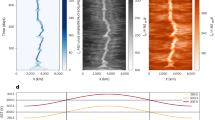Abstract
The Earth’s climate system in the twentieth century has experienced significant effects due to human-influenced factors. In this paper, we focus on the manner in which anthropogenic aerosols have radiatively forced changes in temperature and precipitation and contrast the effects with that due to the influence of well-mixed greenhouse gases. We employ the NOAA/Geophysical Fluid Dynamics Laboratory 3rd generation global climate model to simulate and derive a mechanistic understanding of the response to the forcings. We find that, over the twentieth century, anthropogenic aerosols have counteracted greenhouse gas effects to a substantial extent with regards to climate forcing, temperature and precipitation. The manner in which this comes about is traced through the effects on the atmosphere and surface heat balance, with resultant effects on the hydrologic cycle. Understanding of the twentieth century precipitation change is a prerequisite for confidence in model-based projections of the effects in the twenty-first century in response to emission scenarios of greenhouse gases and aerosols.
Access this chapter
Tax calculation will be finalised at checkout
Purchases are for personal use only
Similar content being viewed by others
References
Bollasina MA, Ming Y, Ramaswamy V (2011) Anthropogenic aerosols and the weakening of the South Asian summer monsoon. Science 334:502–505. https://doi.org/10.1126/science.1204994
Bollasina MA et al (2014) Contribution of local and remote anthropogenic aerosols to the 20th century weakening of the South Asian monsoon. Geophys Res Lett 41(2). https://doi.org/10.1002/2013GL058183
Chung CE, Ramanathan V (2006) Weakening of North Indian SST gradients and the monsoon rainfall in India and the Sahel. J Clim 19:2036–2045. https://doi.org/10.1175/JCLI3820.1
Dong W, Ming Y, Ramaswamy V (2020) Projected changes in South Asian monsoon low-pressure systems. J Clim 33(17). https://doi.org/10.1175/JCLI-D-20-0168.17275-7287
Donner LJ et al (2011) The dynamical core, physical parameterizations, and basic simulation characteristics of the atmospheric component AM3 of the GFDL Global Coupled Model CM3. J Clim 24(13). https://doi.org/10.1175/2011JCLI3955.1
Forster P et al (2007) Changes in atmospheric constituents and in radiative forcing. In: Solomon S et al (eds) Climate change 2007: the physical science basis. Cambridge University Press, pp 129–234
Griffies SM et al (2011) The GFDL CM3 coupled climate model: characteristics of the ocean and sea ice simulations. J Clim 24(13). https://doi.org/10.1175/2011JCLI3964.1
IPCC (2001) Climate change 2001: the scientific basis. In: Houghton JT et al (eds). Cambridge University Press, 881 pp
IPCC (2007) Climate change 2007: the physical science basis. In: Solomon S et al (eds). Cambridge University Press, 996 pp
IPCC (2013) Climate change 2013: the physical science basis. In: Stocker TF et al (eds). Cambridge University Press, 1535 pp
Levy II H et al (2013) The roles of aerosol direct and indirect effects in past and future climate change. J Geophys Res Atmos 118. https://doi.org/10.1002/jgrd.50192
Manabe S, Stouffer RJ (1980) Sensitivity of a global climate model to an increase of CO2 concentration in the atmosphere. J Geophys Res 85(C10):5529–5554
Ming Y, Ramaswamy V (2009) Nonlinear climate and hydrological responses to aerosol effects. J Clim 22:1329–1339. https://doi.org/10.1175/2008JCLI2362.1
Ming Y, Ramaswamy V (2011) A model investigation of aerosol-induced changes in tropical circulation. J Clim 24:5125–5133. https://doi.org/10.1175/2011JCLI4108.1
Ming Y et al (2007) Modeling the interactions between aerosols and liquid water clouds with a self-consistent cloud scheme in a general circulation model. J Atmos Sci 64(4). https://doi.org/10.1175/JAS3874.1
Mitchell JF, Johns TC, Gregory JM, Tett SFB (1995) Climate response to increasing levels of greenhouse gases and sulfate aerosols. Nature 376:501–504. https://doi.org/10.1038/376501a0
Myhre G et al (2013) Anthropogenic and natural radiative forcing. In: Stocker TF et al (eds) Climate change 2013: the physical science basis. Cambridge University Press, pp 659–740
Naik V et al (2013) Impact of preindustrial to present day changes in short-lived pollutant emissions on atmospheric composition and climate forcing. J Geophys Res Atmos 118. https://doi.org/10.1002/jgrd.50608
Ocko IB, Ramaswamy V, Ming Y (2014) Contrasting climate responses to the scattering and absorbing features of anthropogenic aerosol forcings. J Clim 27:5329–5345. https://doi.org/10.1175/JCLI-D-13-00401.1
Paynter D, Frolicher TL (2015) Sensitivity of radiative forcing, ocean heat uptake, and climate feedback to changes in anthropogenic greenhouse gases and aerosols. J Geophys Res. https://doi.org/10.1002/2015JD023364.
Persad G, Ming Y, Ramaswamy V (2014) The role of aerosol absorption in driving clear-sky solar dimming over East Asia. J Geophys Res Atmos 119(17). https://doi.org/10.1002/2014JD021577
Polson D, Bollasina M, Hegerl GC, Wilcox LJ (2014) Decreased monsoon precipitation in the Northern Hemisphere due to anthropogenic aerosols. Geophys Res Lett 41:6023–6029. https://doi.org/10.1002/2014GL060811
Ramanathan V (1981) The role of ocean-atmosphere interactions in the CO2 climate problems. J Atmos Sci 38:918–930. https://doi.org/10.1175/1520-0469(1981)038%3c0918:TROOAI%3e2.0.CO;2
Ramanathan V, Crutzen PJ, Kiehl JT, Rosenfeld D (2001) Aerosols, climate, and the hydrological cycle. Science 294:2119–2124. https://doi.org/10.1126/science.1064034
Ramaswamy V (2009) Anthropogenic climate change in Asia: key challenges. EOS 90(49):469–471
Ramaswamy V, Chen C-T (1997) Linear additivity of climate response for combined albedo and greenhouse perturbations. Geophys Res Lett 24(5):567–570
Ramaswamy V et al (2001) Radiative forcing of climate change. In: Houghton JT et al (eds) Climate change 2001: the scientific basis. Cambridge University Press, pp 349–416
Ramaswamy V et al (2019) Radiative forcing of climate: the historical evolution of the radiative forcing concept, the forcing agents and their quantification, and applications. In: A century of progress in atmospheric and related sciences: celebrating the American Meteorological Society centennial. Meteorological monographs, vol 59. American Meteorological Society, Boston. https://doi.org/10.1175/AMSMONOGRAPHS-D-19-0001.114.1-14.100
Randles CA, Ramaswamy V (2008) Absorbing aerosols over Asia: a geophysical fluid dynamics laboratory general circulation model sensitivity study of model response to aerosol optical depth and aerosol absorption. J Geophys Res 113:D21203. https://doi.org/10.1029/2008JD010140
Seinfeld JH et al (2016) Improving our fundamental understanding of the role of aerosol–cloud interactions in the climate system. Proc Natl Acad Sci 113(21). https://doi.org/10.1073/pnas.1514043113
Smith CJ et al (2020) Effective radiative forcing and adjustments in CMIP6 models. Atmos Chem Phys 20:9591–9618. https://doi.org/10.5194/acp-20-9591-2020
Zhang X, Zwiers F, Hegerl G et al (2007) Detection of human influence on twentieth-century precipitation trends. Nature 448:461–465
Author information
Authors and Affiliations
Corresponding author
Editor information
Editors and Affiliations
Rights and permissions
Copyright information
© 2021 The Author(s), under exclusive license to Springer Nature Singapore Pte Ltd.
About this chapter
Cite this chapter
Ramaswamy, V., Ming, Y., Schwarzkopf, M.D. (2021). Forcing of Global Hydrological Changes in the Twentieth and Twenty-First Centuries. In: Pandey, A., Kumar, S., Kumar, A. (eds) Hydrological Aspects of Climate Change. Springer Transactions in Civil and Environmental Engineering. Springer, Singapore. https://doi.org/10.1007/978-981-16-0394-5_3
Download citation
DOI: https://doi.org/10.1007/978-981-16-0394-5_3
Published:
Publisher Name: Springer, Singapore
Print ISBN: 978-981-16-0393-8
Online ISBN: 978-981-16-0394-5
eBook Packages: EngineeringEngineering (R0)




